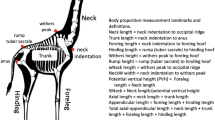Abstract
Fluctuations in water vole population size depend on abiotic and intra-population factors affecting the physiological condition of females. The relationship between reproductive success variability and morpho-physiological indices of females during pregnancy is studied quite poorly. In standard vivarium conditions, the morphometric and hormonal indices of females were assessed at different terms of pregnancy (first trimester—days 4–7, second trimester—days 8–14, third semester—days 15–20), and their relationship with potential and realized fertility and embryonic death rate was examined. The general regression model was used for the data analysis. Positive correlations were found between the potential fertility and the female body mass at mating, condition index, white adipose tissue index, and blood testosterone level. The reproductive indices under study were independent of the blood thyroxin level. A positive correlation was established between the level of embryonic loss and the liver and lung indices. Liver and spleen are essential for the maintenance of the female body mass homeostasis during the reproductive period.
Similar content being viewed by others
References
Rogov, V.G., Population size dynamics and demographic population parameters in the water vole (Arvicola terrestris L.) population from the West Siberian Taiga, Candidate Sci. Dissertation, Novosibirsk, 1999.
Evsikov, V.I., Gerlinskaya, L.A., Moshkin, M.P., Muzyka, V.Yu., Nazarova, G.G., Ovchinnikova, L.E., Potapov, M.A., and Rogov, V.G., Genetico-physiological bases of population homeostasis, Vodnaya polevka, “Vidy fauny Rossii i sopredel’nykh stran” (Water Vole, “Fauna Species of Russia and Neighboring Countries”), Moscow, 2001, pp. 386–412.
Muzyka, V.Y., Nazarova, G.G., Potapov, M.A., Potapova, O.F., and Evsikov, V.I., The effect of habitat hydrology on intraspecies competition, settlement structure and seproduction in the water vole (Arvicola terrestris), Contemp. Probl. Ecol., 2010, vol. 3, no. 5, pp. 606–610.
Moshkin, M.P., Gerlinskaya, L.A., Zavjalov, E.L., Kolosova, I.E., Rogovin, K.A., and Randall, J.A., Stress and nutrition in the wild, Recent Advances in Animal Nutrition in Australia, 2003, vol. 14, pp. 11–22.
Nazarova, G.G. and Evsikov, V.I., Effect of mother’s physical condition during pregnancy and lactation on postnatal growth and reproductive success of offspring in water vole Arvicola terrestris, Russ. J. Dev. Biol., 2008, vol. 39, no. 2, pp. 100–107.
Nazarova, G.G. and Evsikov, V.I., The ability to accumulate fat reserves during pregnancy inherited in the maternal line increases the viability and reproductive potential of daughters: an example of water voles Arvicola amphibious, Dokl. Akad. Nauk, 2012, vol. 445, pp. 276–278.
Nazarova, G.G. and Evsikov, V.I., The evolutionary ecology of animal fertility: the Fitness of progeny is determined by their prenatal development (according to the example of the european water vole, Arvicola terrestris L.), Russ. J. Genet.: Appl. Res., 2012, vol. 2, pp. 23–28.
Speakman, J.R., The physiological costs of reproduction in small mammals, Philos. Trans. R. Soc. Lond. B. Biol. Sci., 2008, vol. 363, pp. 375–398.
Yuzhik, E.I., Proskurniak, L.P., and Nazarova, G.G., Dynamics of morphophysiological characteristics in female water voles (Arvicola amphibius L.) during pregnancy, Zh. Evol. Biokhim. Fiziol., 2013, vol. 49, pp. 290–295.
Savchenko, T.E., Nazarova, G.G., and Evsikov, V.I., Differential sex-dependent postimplantation embryonic mortality in the water vole (Arvicola amphibius), Dokl. Akad. Nauk, 2014, vol. 454, pp. 56–58.
Land, R.B., Genetic and phenotypic relationships between ovulation rate and body weight in the mouse, Genet. Res., 1970, vol. 15, pp. 171–182.
Milona, A., Owen, B.M., van Mil, S., Dormann, D., Mataki, C., Boudjelal, M., Cairns, W., Schoonjans, K., Milligan, S., Parker, M., White, R., and Williamson, C., The normal mechanisms of pregnancy-induced liver growth are not maintained in mice lacking the bile acid sensor Fxr, Am. J. Physiol., Gastrointest. Liver Physiol., 2010, vol. 298, pp. G151–G158.
Selman, C., Lumsden, S., Bunger, L., Hill, W.G., and Speakman, J.R., The resting metabolic rate and morphology in mice (Mus musculus) selected for high and low food intake, J. Exp. Biol., 2001, vol. 204, pp. 777–784.
Herrera, E., Lipid Metabolism in pregnancy and its consequences in the fetus and newborn, Endocrine, 2002, vol. 19, pp. 43–55.
Augustine, R.A., Ladyman, S.R., and Grattan, D.R., From feeding one to feeding many: hormone-induced changes in body weight homeostasis during pregnancy, J. Physiol., 2008, vol. 586, pp. 387–397.
Glinoer, D., Pregnancy and iodine, Thyroid., 2001, vol. 11, pp. 471–481.
Hapon, M.B., Simoncini, M., Via, G., and Jahn, G.A., Effect of hypothyroidism on hormone profiles in virgin, pregnant and lactating rats, and on lactation, Reprod., 2003, vol. 126, pp. 371–382.
Jackson, J.A. and Albrecht, E.D., The development of placental androstenedione and testosterone production and their utilization by the ovary for aromatization to estrogen during rat pregnancy, Biol. Reprod., 1985, vol. 33, pp. 451–457.
Carlsen, S.M., Jacobsen, G., and Romundstad, P., Maternal testosterone levels during pregnancy are associated with offspring size at birth, Eur. J. Endocrinol., 2006, vol. 155, pp. 365–370.
Wolf, C.J., Hotchkiss, A., Ostby, J.S., LeBlanc, G.A., and Gray, L.E. Jr., Effects of prenatal testosterone propionate on the sexual development of male and female rats: a dose-response study, Toxicol. Sci., 2002, vol. 65, pp. 71–86.
Myers, P. and Master, L.L., Reproduction by Peromyscus maniculatus: size and compromise, J. Mammal., 1983, vol. 64, pp. 1–18.
Author information
Authors and Affiliations
Corresponding author
Additional information
Original Russian Text © E.I. Yuzhik, L.P. Proskurnyak, G.G. Nazarova, 2015, published in Zhurnal Evolyutsionnoi Biokhimii i Fiziologii, 2015, Vol. 51, No. 2, pp. 122–126.
Rights and permissions
About this article
Cite this article
Yuzhik, E.I., Proskurnyak, L.P. & Nazarova, G.G. Correlations of reproductive indices of water vole females (Arvicola amphibius) with morphometric and hormonal characteristics. J Evol Biochem Phys 51, 139–144 (2015). https://doi.org/10.1134/S0022093015020076
Received:
Published:
Issue Date:
DOI: https://doi.org/10.1134/S0022093015020076




